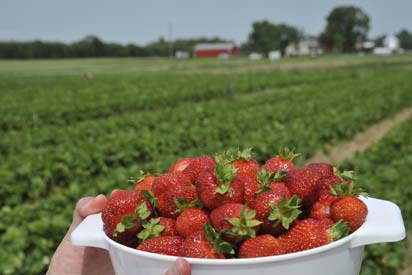Shoppers Prefer Locally-Grown Food, Study Finds

If that carrot traveled across state lines, I’m not eating it! Even if it costs more to buy one that didn't.
That's the attitude of more and more foodies, and a new study finds that grocery store shoppers, in general, are willing to shell out more money for locally-grown foods than they would for the same product trucked, shipped or flown in from farther away. The effect was even more pronounced among shoppers at farmers markets.
"This is an indication that certain groups out there value locally produced food and if farmers deliver that, it makes these consumers happier, so it’s good for them, too," said Marvin Batte, a professor of agricultural, environmental and development economics at Ohio State University, and lead author of the study.
Batte and his colleagues surveyed shoppers, offering them choices between conventional strawberries and locally-grown strawberries. The team found that consumers at grocery stores were willing to pay 42 cents more, on average, for the local berries, and that buyers at farmer's markets were happy to shell out 92 cents extra. With the quarts of strawberries selling for $3 when subjects were surveyed, this meant an increase in one-sixth, and one-third, respectively, of the total price.
The results of the study, funded by the National Research Initiative of the U.S. Department of Agriculture, the Fred N. VanBuren Program in Farm Management at Ohio State, and the Ohio Agricultural Research and Development Center, were detailed in the May issue of the American Journal of Agricultural Economics.
People who chase after locally-grown food — sometimes called "locavores" — do so for a variety of reasons.
The most common motive reported to the researchers: "It's better quality food, it tastes better, it's fresher," Batte told LiveScience.
Sign up for the Live Science daily newsletter now
Get the world’s most fascinating discoveries delivered straight to your inbox.
The next most common response was from shoppers who cared about supporting community businesses and keeping the money they spend in their neighborhood economy.
Furthermore, locally-grown food may be attractive to people concerned about the environmental impact of transporting food: The farther it travels, the more carbon it produces, said Tim Schlitzer, the executive director of the Food Routes Conservancy, a non-profit organization that works to build the local food movement.
And some consumers simply feel reassured when the distance between farm and plate isn't so vast.
"They know where it comes from, they may know the farmer and get to know how they grow things," Schlitzer said. "They are looking for someone who can actually tell them how it was grown."
For consumers concerned about buying sustainably-grown food, or eating produce made without potentially harmful chemicals and pesticides, it may be easier to ensure local food meets these criteria compared with conventionally-farmed products.
Survey says
The researchers analyzed the results of 477 surveys from people shopping at various grocery stores, farmer's markets, and farms themselves, all in the Midwest. Batte's team offered two baskets of strawberries under 80 different combinations of price, farm location and farm type, and asked shoppers which option they would prefer to buy.
"Statistically, we sorted out what explains each person choosing one basket over the other," Batte said. "We were able to determine how important price was, how important where the strawberries were produced was and whether the freshness guarantee was a factor. Basically what made the biggest difference was local production."
The scientists also tested how much the type of farm the strawberries came from mattered. They offered baskets from a fictional producer called "Fred's" compared to baskets from a fake company called "Berries Inc." Grocery store shoppers gladly forked over 17 extra cents for Fred's fruit, and farmer's market shoppers paid a whopping 42 cents more for the berries they thought came from a small farm.
Is Purdue local?
Batte said consumption of locally-grown foods is "increasing fairly dramatically," though he doesn't have statistics, partly because the definition of "locally-grown" can change. For example, local in California, a huge state with multiple agricultural regions, may mean something different than it would in New England, where several small states are clustered together.
And for many shoppers, preferring locally-grown doesn't simply mean caring about how many miles the food has travelled, but also the practices used to produce it.
"Conventional can be local," Schlitzer said. "You can live in Maryland and Purdue chicken is right there, but they're not considered sustainable. That’s not what people are looking for. They're looking for the small farmer who feeds the chickens healthy food and they're well-exercised."
Depending on where you live, local food may not be the more expensive option.
"In terms of price, I know people are willing to pay more, but in a lot of cases you pay a lot less," Schlitzer said. "
Buying food in season from a small farm in the immediate area, where marketing, packaging and shipping costs are lower, can be cheaper than out-of-season produce shipped from another country, he said.
With the rising price of gas lately, this may become more and more true.










